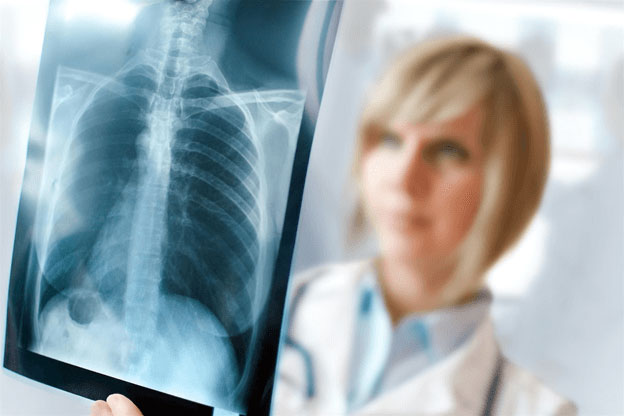Ask the Experts: Which Tests Are Best for Diagnosing Low Back Pain?
The vast majority of people experience some form of back pain at some point in their lives. According to the American Chiropractic Association, 31 million Americans suffer from low back pain at any given time. Globally, it is the number one cause of disability and one of the most cited reasons for missed work.1
Unfortunately, low back pain can be a sign of an underlying problem—anything from traumatic injury to osteoarthritis. The challenge for healthcare providers is to diagnose the correct disease so they can recommend the appropriate treatment. While there are a number of diagnostic imaging tests physicians can use to determine the cause of a patient’s pain—CT scans, MRIs, nuclear imaging studies—choosing the most appropriate test is not always a straightforward decision, and experts often disagree on the best course of action.
In this case study, we look at a classic case of lower back pain and then ask the doctors what they recommend in the form of diagnostic imaging tests.
A Case Study in Lower Back Pain2

A 46-year-old man named Jim shows up at Och Spine at NewYork-Presbyterian at the Weill Cornell Medicine Center for Comprehensive Spine Care complaining of lower back pain. He says he hasn’t experienced any traumatic injuries and doesn’t know why his back hurts. When asked to describe his symptoms in more detail, Jim points to the right side of his lower back area and says he feels a sharp pain that gets worse when he extends his spine and gets better when he bends forward.
After performing a number of basic tests, Jim’s healthcare provider rules out any serious neurological diseases or bone fractures. She prescribes nonsteroidal anti-inflammatory drugs to relieve the pain, muscle relaxants to help with sleep, and physical therapy to aid recovery. Unfortunately, eight weeks of intense exercises, massages, and decompression therapy do nothing to eliminate the pain. Tired of the constant aching and worried about the underlying causes, Jim returns to the Spine Center to discuss his treatment options.
Using Imaging Technology to Uncover the Problem

Both of Jim’s doctors agree that his symptoms are consistent with osteoarthritis (OA), also known as degenerative arthritis. When osteoarthritis affects certain joints in the lower back known as facet joints or z-joints, it’s called z-joint disease. Both Physician #1 and Physician #2 noted that an estimated 15 to 40 percent of all low back pain is connected to z-joint disease. The fact that Jim’s symptoms have not improved as a result of the physical therapy and anti-inflammatory drugs further suggests that this may be the underlying problem.
Both physicians also agree that recording a patient’s history and conducting a physical examination are not enough to diagnose osteoarthritis. For that, you need special imaging scans that provide an accurate picture of the affected area. Only then can they get a better sense of what might be causing the pain. There are a number of such imaging studies available to Jim’s medical team, but they’ve narrowed the options down to two—MRIs and nuclear scans. So which is most appropriate in this case?
Which Form of Imaging Technology Is Most Appropriate? A Q&A with the Experts
Unfortunately, Jim’s doctors disagree over which test they should perform—magnetic resonance imaging (MRI) or nuclear medicine imagining. Both tests have their pros and cons; both are used by physicians to diagnose spinal conditions. In this Q&A, the two physicians choose sides and tell us why they prefer one diagnostic test over the other.
Q: Which imaging procedure do you recommend?
Physician #1: I would suggest nuclear medicine imaging, a state-of-the-art diagnostic procedure. Although initially created to uncover bone tumors and other malignant diseases, they are increasingly proving effective at identifying degenerative diseases like osteoarthritis.
Physician #2: According to the American College of Radiology (ACR), an MRI is the most appropriate imaging study for this scenario. Based on the recommendations of a panel of experts, the ACR concluded that MRIs are more appropriate than either CT scans or nuclear scans. That determination was based on whether “the expected health benefit exceeds the expected negative consequences by a sufficiently wide margin that the procedure is worth doing, exclusive of cost.” 2
Q: How do the tests work and why did you choose them?
Physician #1: With a nuclear imaging scan, a technician injects very small doses of radioactive substances into the patient’s body. By using specialized detection equipment, we can then take images of the radiation emitted by the substances. That gives us an accurate picture of the underlying bones. That will tell us whether the patient suffers from inflammation that could be related to osteoarthritis.
Physician #2: An MRI is the right choice because most people who suffer from OA in the lower back experience something called intervertebral disk degeneration, a condition that leads to deterioration of the disks in the spine. In the vast majority of cases, patients experienced degeneration of their disks before they suffer from z-joint problems.
An MRI can easily detect signs of disk degeneration. In fact, one study showed that out of 41 patients who suffered from osteoarthritis in their z-joints, 40 had MRI results that showed signs of disk degeneration.
Q: Why not use other tests?
Physician #1: CT scans and MRIs are great for showing obvious signs of joint abnormalities such as cartilage loss and narrowing of the space between the joints, but in many cases those markers are not connected with osteoarthritis. They could simply be signs of the normal aging process. Indeed, such joint abnormalities are often present in older people who feel no back pain at all.
In this case, the patient presents with clear symptoms of OA. There are no red flags suggesting that other conditions may be the cause of his pain. A more comprehensive MRI is therefore unnecessary. Instead, the targeted nuclear scan is the most appropriate option.
In fact, there is plenty of evidence suggesting that MRIs do not lead to an accurate diagnosis of osteoarthritis. Unfortunately, many physicians still use them on patients who present with OA symptoms. That only increases the already considerable costs of treating low back pain.
Physician #2: An MRI has three primary advantages. 1) A number of other diseases can masquerade as z-joint disease. Similarly, other conditions can be present at the same time. An MRI allows physicians to eliminate other potential causes. 2) MRIs are also useful for evaluating the integrity of the lumbar spine. 3) MRIs do not expose patients to radiation and do not require intravenous injections.
All of these benefits help physicians diagnose the problem correctly while minimizing the chances of harm, particularly since they do not expose patients to radiation. Since a diagnosis of z-joint disease has not been confirmed in this case, it’s best to use an MRI as the first line of defense in case other diseases are to blame. It is the most thorough and least invasive diagnostic test available.
Q: How do the tests help relieve a patient’s symptoms and improve their outlook?
Physician #1: By obtaining accurate images of a patient’s spine, healthcare providers can locate the exact area that is causing the pain. That allows them to target pain injections to the precise location that is creating the problem.
Patients who receive targeted injections based on the results of nuclear imaging scans tend to experience greater pain relief than patients who rely on symptoms alone to guide the injections. According to one study, 87 percent of patients felt relief after targeted injections based on nuclear imaging, while only 12 percent of patients felt relief after injections based merely on symptoms.
Physician #2: An MRI provides the same benefit of helping therapists more accurately target pain injections.
Conclusion
While each test has its pros and cons, both will give a fairly accurate picture of Jim’s spine and what may be causing his pain. Although Jim’s physicians cannot agree on the best imaging scan to perform, they do agree that he most likely suffers from osteoarthritis. They also agree that choosing the most appropriate procedure depends largely on a matter of efficiency (i.e. which test provides the most accurate results in the quickest amount of time with the least amount of potential side effects).
In either case, Jim will receive the best spinal care available. As Physician #2 notes, however, an MRI does provide the greatest benefit with the least amount of risk, since it does not involve any exposure to radiation.
Pain Management Strategies: Dr. Singh’s Minimally Invasive Treatment Plans
The point of identifying the underlying cause of back pain is to be able to treat the symptoms more effectively. As such, accurate diagnosis and precise location of the problem area is critical to any pain mitigation plan.
As a board certified sports and pain specialist, Dr. Jaspal Ricky Singh, M.D. provides interventional pain management treatment for patients who suffer from lower back pain. In addition to patient education, his practice specializes in procedures ranging from acupuncture and injections to nerve blocks and regenerative medicine. Dr. Singh relies on state-of-the-art diagnostic tests to deliver targeted and minimally invasive treatments to each of his patients.
Visit the website to read more about Dr. Singh’s approach to pain management and the procedures he performs.
Sources:
- American Chiropractic Association –http://www.acatoday.org/Patients/Health-Wellness-Information/Back-Pain-Facts-and-Statistics
- The rest of this article is based on a point/counterpoint discussion between J. Levi Chazen, MD and Jason Talbott, MD that was originally published in PM&R, the official scientific journal of the American Academy of Physical Medicine and Rehabilitation (AAPM&R).
Optimal Noninvasive Imaging for Suspected Zygapophyseal (Facet)-Mediated Low Back Pain. Chazen, J. Levi et al. PM&R, Volume 8, Issue 6, 586 – 592
http://www.pmrjournal.org/article/S1934-1482(16)30063-6/abstract
We’ve Got Your Back
For more information about our treatment options, contact our office today.



